Jim Cookinham
Traveling Man led Town's TechJim Cookinham was born during WWII, in 1945 in Kansas. Both of his parents graduated from the University of Kansas. At the time of his birth his father was a Navy Officer in the Pacific. From Kansas, they moved to Seattle until he was just over three years old and then spent the next two years in Guantanamo. "Most people don't know I was in Guantanamo for two years, but it was really a nice place then. And of course, this was before Castro."
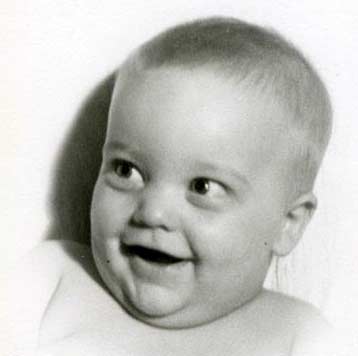
Baby Jim Cookinham in 1945
His father was then transferred to the Pentagon and the family moved again, this time to Washington. When Jim was eight his father was assigned to the Mediterranean Fleet. Jim's mother and another Navy wife decided not to sit home and wait for their husbands to come home, so they packed up and moved to Mallorca, Spain. This was 1953 and Mallorca was completely unknown. Franco was the only dictator remaining in power, so he was completely isolated from the rest of Europe. He entered into an agreement with the United States in which the U.S. gave financial support in exchange for the right to build both Naval and Air Force bases in Spain. 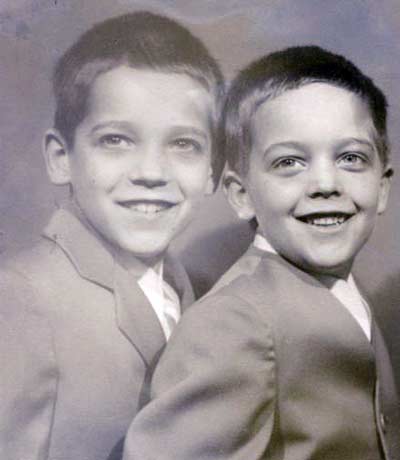
Jim and Garth Cookinham in 1952
The family, which consisted of Jim, his parents and his brother, Garth, took to living in Mallorca, but it was a very different life than he would have had in the US. In fact, Jim started a business at about age 9. It was a beer and pop distribution company. Jim would sell the beverage to an assortment of customers and Garth would deliver the product on his donkey. "It was a big job for a 10 year old but I did make money." They had no television, no sports, no formal school; his mother home schooled Jim through grade seven. From the ages of eight to fifteen, Jim never left Spain. He knew nothing about American sports or trends, but he could speak Spanish like a native and was a stone's throw off his dirt road to the Mediterranean. In the meantime, Jim's father came back to the United States, but his mother refused to follow. His parents ultimately divorced and he and Garth stayed in Spain. Jim made friends during that time that he still cherishes and sees to this day. Jim came back to Topeka, Kansas in time for the ninth grade. He had a hard time understanding what the other kids were talking about. Any references they made to sports or pop culture were beyond him. "I didn't have TV for seven years, so I had no idea what the other kids were talking about. Talk about feeling out of it!" Jim had known early on that he wanted to go to the Naval Academy. When he went into ninth grade he started reading up on all of the things they look for in the students they accept. So High School was a lot easier for him, because he started to get involved in many different things. The Naval Academy liked students who had exhibited leadership skills, so he became president of different groups. Whatever traits the Naval Academy was looking for, Jim honed. He was accepted into both West Point and the Air Force Academy, but no appointment was available to the Naval Academy. He enrolled at the University of Kansas where he joined Phi Delta Theta. The fraternity's mission statement lists three main objectives, "…The cultivation of friendship among its members, the acquirement individually of a high degree of mental culture, and the attainment personally of a high standard of morality." This suited Jim just fine. 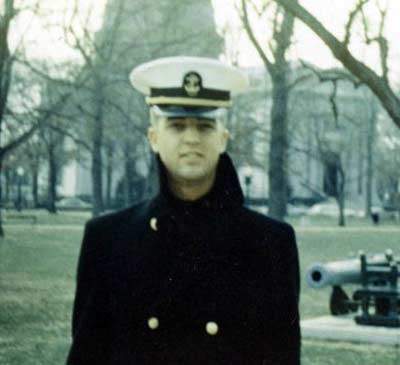
Midshipman Jim Cookinham in 1966
He stayed at the University of Kansas for a year before being accepted into the Naval Academy. Once he transferred to the Academy, he had to start all over - his year at Kansas did not count. "I went from being a pledge to a plebe and being a plebe is much worse."Jim had always wanted to fly on air craft carriers and as a senior took the physical required for the training. His vision was 20/25 instead of the required 20/20 and he was not permitted to fly. As an engineering major, he wasn't sure what other field he should go into, but decided to apply to the nuclear submarine program. He was interviewed by Admiral Rickover, known world wide as the father of the Nuclear Navy. "Admiral Rickover had a reputation for being cantankerous and hard to deal with. And everything I had heard about him was true. He screamed and hollered so much that I was certain I would not be accepted into the program." To his surprise, he was accepted which meant another year after graduation in the study of Nuclear Power. He took these classes in Maryland and Connecticut and became qualified to run a nuclear reactor. "These classes were really, really tough. It's not just me saying it either. They were really tough!" To emphasize his point, Jim says he bought a brand new Porsche when he graduated and never had to put gas in it because he never had time to drive it. Jim finished his training in Connecticut in 1969 and selected a submarine out of Pearl Harbor on which to serve. He could have chosen not to be on a submarine and use his extensive training on a surface ship, but "you got hazardous duty pay on the submarine. I think it was about $300." 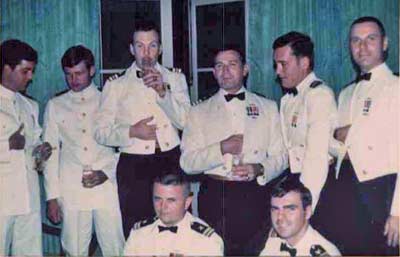
Jim Cookinham and other officers of SSN594 in 1969
He chose a "fast attack" sub rather than a missile sub. It was the U.S.S. Sea Dragon SSN 584. Since his sub was out of Pearl Harbor, Jim moved to Hawaii in 1969 and fell in love with it. He got to play a lot of tennis, snorkel and try his hand at surfing. He also met a young lady by the name of Cindy who had graduated from the University of Kansas. 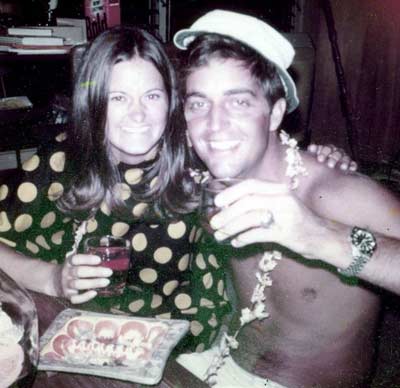
Cindy and Jamie in 1970
In fact, he had dated one of her sorority sisters, though he doesn't remember meeting her there. What started out as a blind date resulted in a marriage in November 1972 that is still going strong and happy today. They were married in Hanalei, Kauai, Hawaii.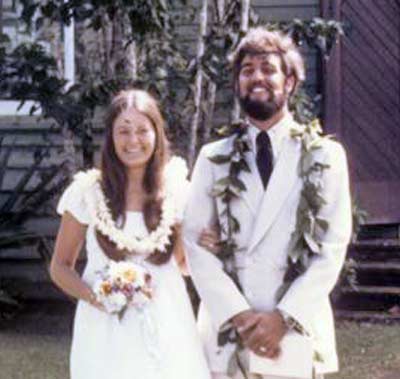
Cindy and Jim Cookinham's wedding in 1972
Viet Nam was in full force at this time, but did not really concern Jim or his submarine because North Viet Nam posed no threat to nuclear submarines. Jim was a Lieutenant and the weapons officer on the sub. He went on a West-Pac tour from 71-72, which is service time in the Western Pacific. They were out to sea for eight months and were submerged for about 60 days at a time. "You do get a little tired of some of the people after awhile." In 1973 they went up under the northern ice cap, although he did not go to the North Pole. They broke through about 38 inches of ice. He thinks that most people on board the sub don't really try to understand what is going on - that they are so far beneath the frozen water. He was the Officer on Deck at the time they went under, and as such had to be prepared to react within seconds. So for Jim, he was forced to deal with the actuality of the submersion and did not have the luxury of ignoring it. 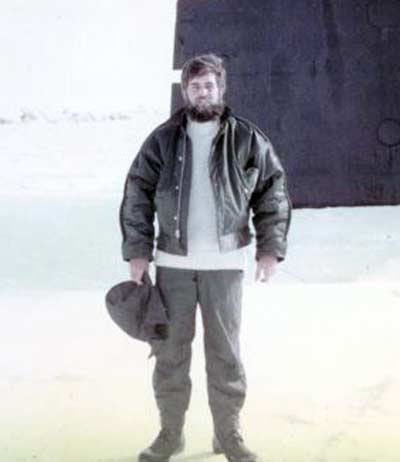
Jim Cookinham on the ice with the Sea Dragon in 1973
The average depth of the ice during the mission was 60 feet. The average depth of the water was 300 feet and the depth of the ship was approximately 60 feet. So they did not have a lot of room between the ice above and the ocean floor. "In some cases we could hit the top and bottom at the same time." This was one of the few missions they were allowed to take pictures and talk about their experiences. The rest of the missions had high security ratings and could not be discussed, even with loved ones. When his five years were up, Jim resigned his commission. He wanted to take some time off and think about his life and his future. Jim and Cindy went back to Kauai - but not for long. They bought a Volkswagen camper and had it shipped to Kauai. They lived there for awhile; surfing every morning, reading, playing tennis, and just taking it easy. After three months, Jim had had enough. It was too much free time for him and he had the urge to "do" something. So they shipped the camper back to California in late 1973 and drove across North America. In January 1974, the Volkswagen took another trip - this time to Europe. Jim and Cindy took a Polish freighter and met up with their well-traveled vehicle. From January through October they drove all around Europe, with the exception of communist countries, which Jim's security classification prohibited. They drove 500 miles north of the Arctic Circle. Up Finland. Down Norway - all over. They missed Greece (although Jim had been there in the past) and Ireland. Greece because they would have had to travel through communist countries and Ireland because they could not drive there. They saw Lichtenstein, The Vatican and Monaco and every country one could think of. When they got to each city they would read up everything they could about it and then go and see what they had just read about. They studied quite a bit while traveling. "It was almost like work." 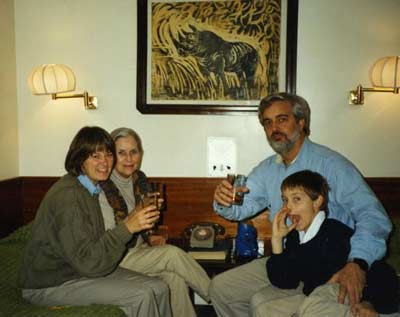
The Cookinhams in Kenya in 1990
They did this all on a very low budget of about $300 a month. When the journey began, they had about $13,000 in the bank so they had to be frugal. They would pull their camper into a campgrounds and would only stay if the grounds were clean and would provide an opportunity for a hot shower. If not, they would move on. They never ate in restaurants.
While in Vienna, Jim started to think about the future and the harsh reality that they could not do this forever. He talked to the International Atomic Energy Commission in Vienna who suggested he talk to Westinghouse Nuclear Europe in Belgium since he was trained on Westinghouse equipment. As fate would have it, the Westinghouse people had committed to building reactors in Spain and to having someone on site within 3 weeks time who was fluent in Spanish and qualified to work on nuclear reactors. After his first interview he was told there was one more person that would need to approve of his being hired, and that person was currently in the U.S. Jim asked what his chances of getting the job were so he knew how to start planning. The reply was comforting. The examiner asked him if he knew how pure Ivory soap was alleged to be (99.9%). That was the same percentage as his chance of being hired. 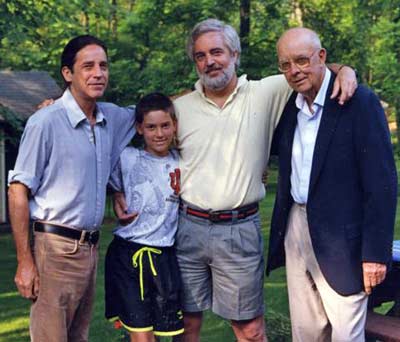
The Cookinham Men in 1983
Jim with brother, son and father
Obviously, he was hired and did training on the reactors in Belgium and Sweden. Cindy came back to the States briefly to get the small amount of "stuff" they had accumulated. By 1974 they were in Caceres, the reactor site, far from the beaten path. Jim and Cindy were the only Americans on the project and at the time, Cindy spoke little Spanish. She was totally immersed in the language and today is fluent. Places like the Open Air market forced her to learn the basics - like asking for what kind of food you wanted. Jim started as a start-up engineer but became site manager within a year. He was about 30 years old at the time.
Again, he started thinking about the future and realized that if he wanted a career in the United States he had to get back. So in 1971 he transferred to Westinghouse's Diablo Canyon Nuclear Plant in San Luis Obispo, California. Cindy taught school while they were there. Next stop - Beaver Valley Nuclear Plant near Pittsburgh where he was site manager until being promoted to Project Manager of the Nuclear Center at Monroeville, Pennsylvania. While he was there, he got an MBA from the University of Pittsburgh. Also during his time in Pennsylvania their only child, Chad, was born on New Year's Eve, 1979.
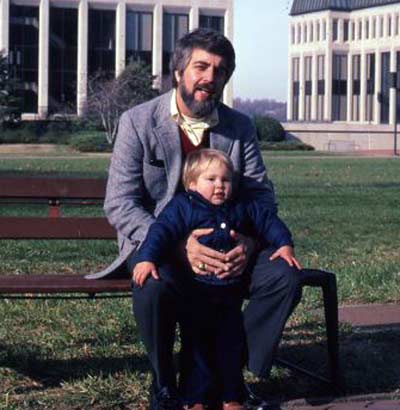
Jim Cookinham in front of the US Naval Academy with son Chad in 1981
And still one more major event took place in 1979. It was March 1979 that the nuclear accident took place at Three Mile Island. "This was not a good thing from a nuclear career point of view." He stayed with Westinghouse until 1984 when he went to work for Panelmatic. His son was now 4 and they moved to Poland, Ohio, a city they really liked.
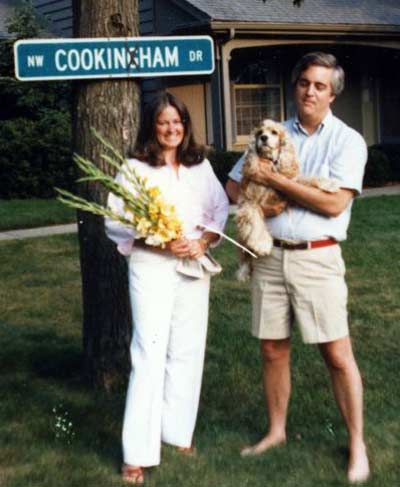
Cindy and Jim Cookinham in Poland, Ohio in 1985
Cindy went back to teaching and became the one and only Kindergarten teacher in the city. 4 more years went by and Jim went to work in Cleveland at Cleveland Thermal, but continued to live in Poland, an eighty-five mile commute each way. "I listened to a lot of books on tape." Hired as Director of Engineering, after only a year, Jim became president of the company. "Most people don't know that there are about 18 miles of pipe under the city that heats downtown Cleveland." Cindy and Jim started a publication in 1981 called IPCO, the first publication for the IBM PC. They did it as a side venture and continued until about 1985 or 86. It was very interesting but again, a time consuming project. It was also the first publication to include a cover disc with each copy.
When Cleveland Thermal was sold in 1991, Jim signed an employment contract with the new owners that included a provision for him to move to Cleveland. They chose Moreland Hills because of the Orange School system. "I knew nothing about East-Side West-Side conflicts, and I still don't understand them. I had no pre-conceived notions about the city. We had a realtor show us houses and we saw Chagrin Falls and decided we liked it." They live about a mile out of Chagrin Falls. Cindy subbed at Orange and Chad went to school there. After a year at Orange, Cindy started teaching at University School. After 3 years at Orange, Chad and a number of his friends transferred to University School. "I think Chad and his friends all wanted to play lacrosse." 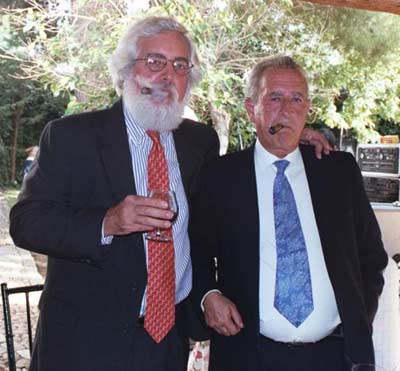
Jim Cookinham with friend Juan in Spain in 2002
Jim stayed on as President until 1995 when the parent company, a utility company in Indianapolis wanted him to move there. He said no. After all his moves through the years Jim realized this time he should stay put. His wife had a job she loved. His son was in a school he loved and the job was just not worth another move. He was given a severance package large enough to let him think about his future. He was only 50 and nowhere near ready to retire. He was approached by the Greater Cleveland Growth Association which was starting up a tech group to help area businesses. He was asked to volunteer to help get this project started and agreed. His son was accepted into Dartmouth and tuition prohibited Jim from staying on as a volunteer for long. He attended a meeting in Salt Lake City of a group called CRITA (Council of Regional Information Technology Association). The group gets together every 6 months and talk about what is happening in the tech world in their area. They discuss what works, what doesn't, share ideas and offer help. People from all over the United States and Canada belong to this group. 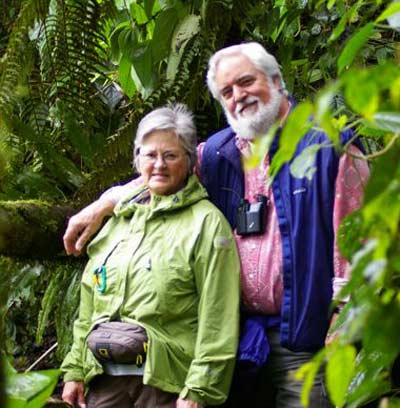
Cindy and Jim Cookinham in the Rainforest in Ecuador in 2005
Jim remembers taking 14 pages of notes and came back with an idea. He proposed incorporating the Growth Association's tech group, having memberships, charging dues and providing him with a salary. The Association gave their blessing and NEOSA was formed (The Northeast Ohio Software Association). Jim had never been in the non-profit world before but he had connections from his CRITA group and became the area expert because of these connections. In 1998-99, the State wanted to build an IT Industry Cluster and Jim was approached by Ohio's IT Alliance and asked if he wanted funding. He was warned by his CRITA associates not to take the money - it was like a drug - but Jim accepted the funding. 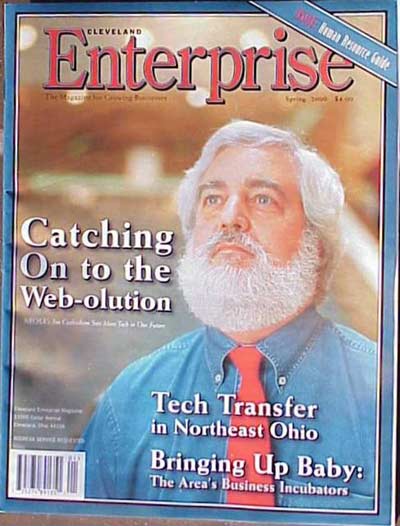
Cover Boy Jim Cookinham in 2000
"This money allowed us to move forward at a very fast pace and hold events and educational seminars without worrying about making a profit."They created an Angel Network, where tech companies were introduced to qualified investors. They also set up Digital Mixers allowing students from all universities in the region to come and talk to tech companies. "This was not a job fair. It was designed to let students know you don't have to move to someplace else. There are tech companies right here." 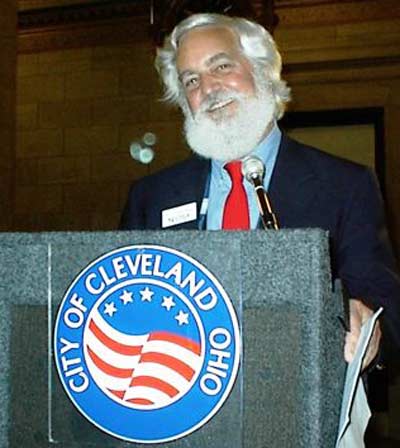
Jim Cookinham speaking at Cleveland City Hall
They sponsored a debate among the mayoral candidates, Ray Pierce and Jane Campbell. Both were asked if they would appoint a Tech Czar if elected and both committed to doing so. "We had given the candidates a number of questions ahead of time and I could tell by the notes they had that they had done a lot of research on the subject. It was a great way to educate the candidiates. Then I would hear them in another speech somewhere else and I would hear them referring to the tech questions. So it educated the candidates as well as got the word out to their constituents." In 2003 the warnings of his colleagues came back to haunt him when his funding was pulled. The state wanted the money to be used more for new companies rather than existing IT companies. The money was given to NorTech (Northeast Ohio Technical Coalition). "The hardest part was not losing the money - I had been warned. But the coverage all read 'NEOSA won't be here in a month' which made it very difficult to collect dues." By now Jim was Chairman of CRITA and was considering the option of merging NEOSA with COSE (Council of Smaller Enterprises, now part of the Greater Cleveland Partnership). His CRITA colleagues again warned him against it describing COSE as basically a "Chamber of Commerce", but he went ahead and the two merged and it has worked well for both NEOSA and COSE. 
NEOSA Awards at Cleveland City Hall in 2003
Jim continued to run NEOSA through COSE until the end of 2005. During his time at NEOSA/COSE he developed a number of programs including the Arts Network, the Small Business Conference, The Home Based Business Network, Mindshare and Mindspring. Mindshare was a networking of business owners. Mindspring is a web portal with editors where small business owners can ask questions and get advice. Jim retired at the end of 2007. His memories of his three months off in Hawaii remind him that he is not good at just sitting around wasting time. His son is now a Dartmouth graduate and is teaching and coaching Lacrosse and Basketball in Connecticut. He spent two years teaching in Ecuador, obviously inheriting the "try it and see what it's like" gene from his parents. He is engaged and will be married this summer in Toledo, Spain. 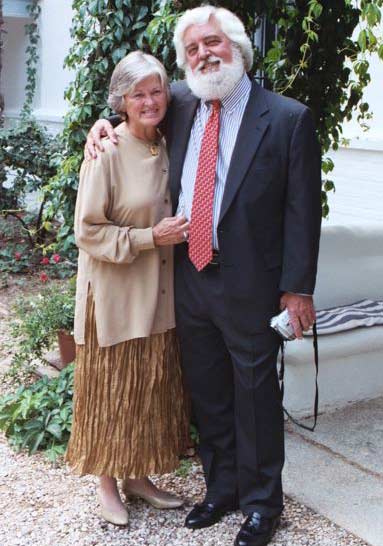
Cindy and Jim Cookinham in Spain 2002
Jim and Cindy just returned from a month in Spain where he still has very strong connections. The friends he made as a child are some of his best friends today and he loves nothing better than to spend time with them. Cindy is now teaching 6th grade math at University School - and very happy with it. "She somehow seems to be happier when she is working." Jim's mother, re-married in 1972 but is now widowed. She is 90 years old and living in East Hampton Long Island. Visiting her and tending to her is one of the more important reasons Jim chose this time in his life to retire. Jim is very active physically as well as mentally. He swims every day and feels terrible on any day he misses. "I feel incredibly better when I swim and when I am in shape. I need to preach to myself sometimes, and I am always happier when I listen." He would love to work in the tech community in some meaningful way, but not in an eighty hour a week capacity. He hopes he has brought attention to the tech community in northeast Ohio. "Before NEOSA so many people felt tech was only in Silicon Valley, which is really not true." He says people don't realize the importance of technology in this area. "Without it" he says, "Progressive won't work here. Cleveland Clinic won't work here. National City Bank won't work here." When he first started NEOSA he counted 2800 tech companies in northeast Ohio and discovered that 5% of the work force and 10% of the salaries where tech related. He would like to learn to do programming now, but just for his own use, not practical application. "When I speak before an audience and say 'we don't have enough people doing C++' I don't know what C++ is. If there were ten screens set up and I was told one of them was C++ I couldn't tell you which one it was." So he would like to be able to understand the basics of programming. 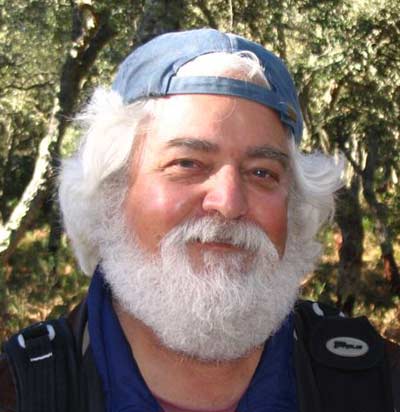
Jim Cookinham in Spain in 2008
He also plans on organizing and cataloging some of his hundreds of photos from his trips, taking advantage of all of the new software programs available. As a child in Spain, he studied classical guitar but always felt intimidated because his brother was so much better at it than he was. He still loves classical guitar music but will probably not be taking it up again in his retirement years. He will have no choice but to spend time with his two black labs, Hana (named for the city in Kauai where he and Cindy were married) and Blue (his mother's maiden name). Both are about four years old and full of love and affection. 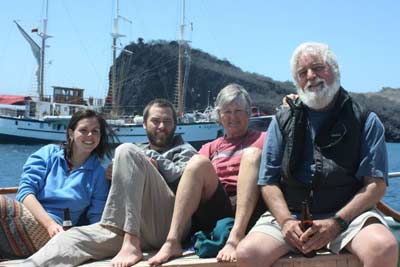
The Cookinhams in the Galapagos in 2007
Of course, there are also places left to see. He has been on safari in Kenya, but has still not gotten to Ireland. He has been to the Galapagos Islands but not to Argentina. The rest of the world awaits him. 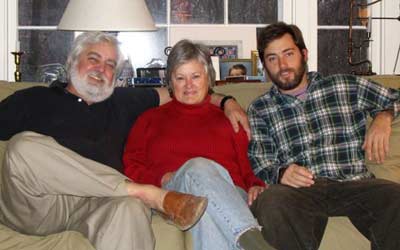
Jim, Cindy and Chad Cookinham at home in 2004
Jim Cookinham is one of those rare people who truly know what they want and how to get it. Whether it is something as serious as qualifying to work on nuclear reactors or as fun as driving through Europe, he approaches each task with the same commitment. He is eager to learn everything about everything and is not afraid to work at doing just that.
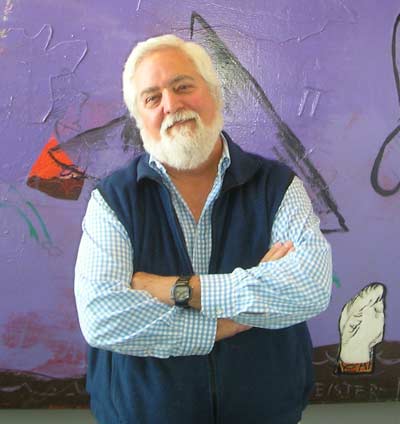
Jim Cookinham in January 2008
He was also smart enough to marry a woman who shared his vision and walked with him while he followed his dream.These are people who know the value of every day and cherish each gift a new day brings. He will not retire to a rocking chair. Jim Cookinham has too much to do and too many places to see.
Profiled by Debbie Hanson (1/08)

See more Photos of Jim Cookinham
See photos and video from Jim Cookinham's retirement party
Top of Page
Back to Profiles of Cleveland Seniors
More Photos of Jim Cookinham
See photos and video from Jim Cookinham's retirement party
| 
